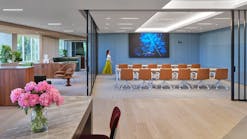Sales and profits both jumped for Signify in the third quarter, buoyed by price increases and strong activity in the professional market that offset a weak consumer sector, although sales slumped in horticulture.
In a positive sign, the company reported on a results call with analysts that general supply-chain difficulties have begun to ease slightly, and CEO Eric Rondolat said the company hopes to protect margins in part by negotiating lower prices from companies that provide its goods.
More internal cost cutting is also in the cards following a year in which Signify shrunk its employee base from 37,069 at the end of 2021’s third quarter to 34,273 at the end of Q3 2022, in part reflecting a high level last year for factory restarts as COVID abated.
For this year’s third quarter ending Sept. 30, comparable sales rose 4.3%, or 16.3% on a nominal basis, to €1.91 billion from €1.64 billion in the same quarter a year ago. Net income hopped 18.4% to €112 million from €94 million a year earlier.
A strong U.S. dollar plus the acquisition of U.S. horticultural firm Fluence and Australian luminaire company Pierlite contributed to the nominal sales increase.
The topline growth came from the company’s Digital Solutions segment, which sells lighting products and services to businesses and the public sector, where users are keen to embrace the energy savings of LED products as energy prices continue to rise around the world, Rondolat said. He pointed out that Signify’s relatively new “Ultra Efficient” line of LED products provides an extra incentive because it adds up to 60% energy savings to LEDs’ already significant efficiency.
Professional sector strong, except for horticulture
For the quarter, Digital Solutions sales hit €1.1 billion, up from €848 million a year ago, a 12% increase on a comparable basis and a 30% leap nominally. Income from operations nearly doubled, to €79 million, from €40 million in last year’s third quarter.
The group’s important horticulture sector, however, did not fare well. Although growers in general are interested in LEDs to help save energy, the rampant rise in energy prices ironically is depriving them of the wherewithal to make the upfront purchase, Rondolat suggested.
“Our horticultural business is temporarily affected by the price of energy,” he told Bank of America Merrill Lynch analyst George Featherstone on the call. “Growers these days are having their P&L pretty much pressured by the higher price of gas and electricity.”
It was a reminder that LED lighting, for all of its benefits, comes at a purchase price that some users cannot afford. Horticulture has generally been a lively growth area for Signify in recent years, including a strong quarter a year ago. Rondolat did not elaborate on the outlook other than labelling the current situation as temporary.
Meanwhile, sales in the consumer sector — which Signify calls “Digital Products” and which includes Hue and WiZ home smart lamps and systems — continued to slump. The previous temporary lift provided by the stay-at-home days of COVID lockdowns is now over, and sales were €609 million, a 2.5% decline on a comparable basis, although nominally a 3.7% increase from €588 million in 2021’s third quarter. Either way, net income from operations fell 13.2%, to €62 million from €72 million.
Conventional products, including fluorescent lights, fell to €195 million in sales, a 9.5% decline on a comparable basis, and a nominal 3.2% slip. Income from operations crashed 61.5%, to €13 million from €32 million.
From a corporate-wide perspective, CEO Rondolat identified three particular trouble spots, including not only Russia but also China, where the economy has run into difficulty. And although a strong dollar favored some topline results, generally unfavorable foreign exchange rates including a strong dollar and Chinese renminbi compared to the euro, plus temporary hedging pushed EBITA operating margins downs to 10.4% from 11.1% a year ago, Rondolat said.
Three months ago, the company also reported a drop in EBITA operating margins, to 9.5% from 10.9% for the second quarter. But in that case, it attributed the tumble largely to its reduction in UV-C product line activity. On today’s analysts’ call, Rondolat did not provide an update on the UV-C line, for which the company once had high hopes. LEDs Magazine has requested one and will report on Signify’s response in a separate article.
Trimming the bill
Rondolat did, however, articulate the means by which Signify will protect margins. Although price rises have played a key role recently, Signify will now be looking for better deals from its own suppliers.
“We think that our costs in the bill of material are going to be going down,” Rondolat told BofA’s Featherstone. “We’re going to be able to negotiate.”
Pressed by Goldman Sachs analyst Daniela Costa on the same subject, he reiterated, “Moving forward, I expect more that we’re going to be capable to increase the gross margin with a reduction of our bill of material. That’s really the objective that we have. Because we know that we can at this point in time position the margin well at the prices where we are. The objective is not to price ourselves out of the market.”
It might also help that the protracted supply-chain difficulties could be easing, as goods are arriving at Signify facilities slightly faster.
“Inventories have peaked and are starting to come down, as lead times are beginning to ease,” Signify chief financial officer Javier van Engelen said in a presentation on the call. Asked for more detail, he noted, “It's still not very significant, but at least we see that the lead times have plateaued and are slightly going down.”
Signify will also trim indirect costs, Rondolat said.
“We believe we need also to act on our non-manufacturing costs,” he said. “We want to eventually further reduce the central part of the organization. At the same time, there may be a few other adaptations that we need to think about.” The changes will bring both cost and speed advantages, he said.
One cost Signify will contend with is labor wages, which Rondolat anticipates rising by between 2.5% and 5%.
Taking the big picture of ongoing economic uncertainties, Rondolat gave a modest outlook for the rest of the year.
“Given the uncertain near-term outlook, the continued softness of the consumer segment and of the Chinese market, we now expect to achieve comparable sales growth between 2% and 3% for the full year 2022,” he said. “Regarding the adjusted EBITA margin and free cash flow, we are targeting the lower end of both guidance ranges.”
That range is 11% to 11.4% for adjusted EBITA margin, and 5% to 7% for free cash flow as a percent of sales.
MARK HALPER is a contributing editor for LEDs Magazine, and an energy, technology, and business journalist ([email protected]).
For up-to-the-minute LED and SSL updates, follow us on Twitter. You’ll find curated content and commentary, as well as information on industry events, webcasts, and surveys on our LinkedIn page and our Facebook page.

Mark Halper | Contributing Editor, LEDs Magazine, and Business/Energy/Technology Journalist
Mark Halper is a freelance business, technology, and science journalist who covers everything from media moguls to subatomic particles. Halper has written from locations around the world for TIME Magazine, Fortune, Forbes, the New York Times, the Financial Times, the Guardian, CBS, Wired, and many others. A US citizen living in Britain, he cut his journalism teeth cutting and pasting copy for an English-language daily newspaper in Mexico City. Halper has a BA in history from Cornell University.






